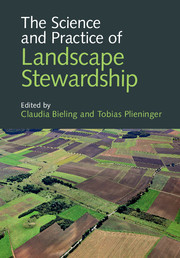Book contents
- The Science and Practice of Landscape Stewardship
- The Science and Practice of Landscape Stewardship
- Copyright page
- Contents
- Contributors
- Preface
- 1 The Emergence of Landscape Stewardship in Practice, Policy and Research
- Part I Foundations of Landscape Stewardship
- Part II Landscape Stewardship on the Ground
- Part III Visions Towards Landscape Stewardship
- 16 Bridging New Sustainable Development Goals, Global Agendas and Landscape Stewardship
- Case 15 Terre de Liens – Facilitating Access to Land for Farmers Into the Long-Term
- 17 How Landscape Stewardship Emerges Out of Landscape Planning
- Case 16 The Dartmoor Vision – A Long-Term, Participatory Management Process on the Landscape Scale
- 18 Art and Responsible Landscape Development
- Case 17 One Hut Full – A Multi-Sensory Journey Turning Threatened Heritage into Opportunity
- 19 Leveraging Landscape Stewardship
- Index
- References
18 - Art and Responsible Landscape Development
A Plea for Landscape Art
from Part III - Visions Towards Landscape Stewardship
Published online by Cambridge University Press: 05 July 2017
- The Science and Practice of Landscape Stewardship
- The Science and Practice of Landscape Stewardship
- Copyright page
- Contents
- Contributors
- Preface
- 1 The Emergence of Landscape Stewardship in Practice, Policy and Research
- Part I Foundations of Landscape Stewardship
- Part II Landscape Stewardship on the Ground
- Part III Visions Towards Landscape Stewardship
- 16 Bridging New Sustainable Development Goals, Global Agendas and Landscape Stewardship
- Case 15 Terre de Liens – Facilitating Access to Land for Farmers Into the Long-Term
- 17 How Landscape Stewardship Emerges Out of Landscape Planning
- Case 16 The Dartmoor Vision – A Long-Term, Participatory Management Process on the Landscape Scale
- 18 Art and Responsible Landscape Development
- Case 17 One Hut Full – A Multi-Sensory Journey Turning Threatened Heritage into Opportunity
- 19 Leveraging Landscape Stewardship
- Index
- References
Summary
- Type
- Chapter
- Information
- The Science and Practice of Landscape Stewardship , pp. 350 - 367Publisher: Cambridge University PressPrint publication year: 2017



